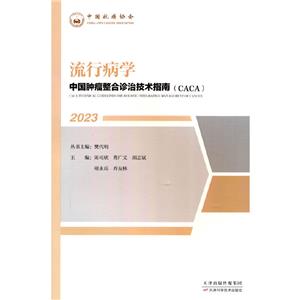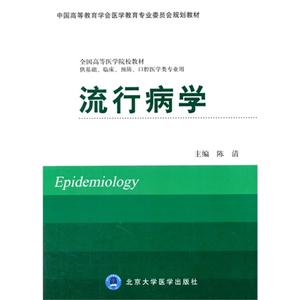
作者:汪培山主编
页数:236
出版社:清华大学出版社
出版日期:2014
ISBN:9787302375111
电子书格式:pdf/epub/txt
内容简介
《流行病学(留学生与双语教学用 英文版)/普通高等教育“十二五”规划教材·全国高等医药院校规划教材》教材系统地介绍了流行病学的基本原理和方法,内容简明易懂,每章后面附有重要专业词汇和部分练习题,适合初学流行病学的临床医学专业的留学生和本科生双语教学作为入门教材,也可以作为其他医学相关专业,如护理学、口腔医学、药学、公共卫生服务等专业的学生学习流行病学的教材。 《流行病学(留学生与双语教学用 英文版)/普通高等教育“十二五”规划教材·全国高等医药院校规划教材》也可以供卫生专业工作人员学习和应用流行病学参考。
目录
Part One Fundamental Epidemiology
Chapter 1 Introduction
1.What is epidemiology?
2.Brief history of epidemiology
3.An overview of methods of epidemiologic studies
4.Goals of epidemiology
5.Natural history of disease
6.Epidemiology and three levels prevention
7.Epidemiology and clinical medicine
Summary
Study Questions
References
Chapter 2 Measures in Epidemiology and Sources of Data
1.Introduction to measures in epidemiology
2.Measures of disease occurrence
3.Other descriptive population health measures
4.Sources of data
Summary
Study Questions
References
Chapter 3 Communicable Diseases
1.What is a communicable disease?
2.Some key concepts of communicable diseases
3.Approaches to the control of communicable disease
4.Infectious disease process
5.The descriptive epidemiology of communicable disease
6.Public health surveillance
7.Epidemic or outbreak investigation
Summary
Study Questions
References
Chapter 4 Survey and Cross瞫ectional Studies
1.Introduction
2.Steps in designing and conducting a survey
3.Sampling
4.Data gathering approaches
5.Biases in health surveys
6.Advantages and pitfalls associated with cross瞫ectional studies
Summary
Study Questions
References
Chapter 5 Cohort Studies
1.What is a cohort study
2.Design of cohort study
3.Cohort selection
4.Data collection
5.Analysis and result interpretation
6.Sample size consideration for a cohort study
7.Potential biases in cohort studies
8.Advantages and disadvantages of a cohort study
Summary
Study Questions
References
Chapter 6 Case瞔ontrol Studies
1.What is case瞔ontrol study?
2.Design of case瞔ontrol study
3.Data analysis
4.Biases in case瞔ontrol study
5.Sample size consideration
6.Advantage and problems of case瞔ontrol study
7.Nested case瞔ontrol study: brief introduction
8.Comparison of characteristics of case瞔ontrol study and cohort study
Summary
Study Questions
References
Chapter 7 Experimental Studies
1.Introduction
2.Example of clinical trials
3.Study designs for randomized controlled trial
4.Sample size consideration
5.Analysis and result interpretation
6.Advantages and disadvantages of experimental studies and compliance
7.Ethical aspects of experimentation with human subjects
8.Assessing the quality of a trial
Summary
Study Questions
References
Chapter 8 Association and Causation
1.Concept of cause in epidemiology
2.Association and causal association
3.Evaluating causal association
Summary
Study Questions
References
Chapter 9 Bias and Confounding
1.Introduction
2.Overview of bias
3.Impact of bias
4.Confounding
Summary
Study Questions
References
Chapter 10 Screening and Early Detection
1.Introduction to screening and early detection
2.Criteria for establishing a screening program
3.Population screening tools
4.Validity, reliability and error
5.Evaluation of screening programs
Summary
Study Questions
References
Part Two Applications of Epidemiology
Chapter 11 Application of Epidemiology in Clinical Practice
1.Prognosis
2.Clinical decision analysis
3.Evidence瞓ased medicine
References
Chapter 12 Molecular and Genetic Epidemiology
1.Definitions and distinction
2.Study methods
References
Chapter 13 Application of Epidemiology on Public Health Service
1.Public health and public health operations
2.Epidemiological model of the delivery of health care services
3.Epidemiology and the public policy process
4.Translational research and translational epidemiology
References
Chapter 14 Descriptive Epidemiology in Cancer: Measures of the
Cancer Burden
1.Cancer incidence and prevalence
2.Cancer mortality
3.Survival rates
4.Temporal trends
5.Geographic variation of cancer
References















